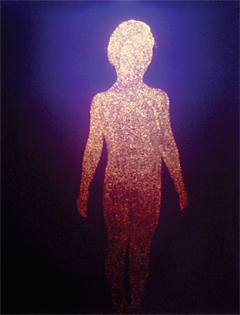The author of this guest post, Cator Shachoy, founder of the nonprofit organization Youth Yoga Dharma, is currently leading a Tricycle community discussion about dealing with pain that arises during meditation. Join in on the discussion here.
 Odds are good that if you sit still for a long time, you will begin to feel pain. Our normal response is to move, to get away from that experience. But what if you don’t? What if you stay, and become curious instead? From this foundation of curiosity, you can grow interested in the experience of pain. What is this thing called “pain”? Is it hard or soft, hot or cold? Does it tingle or vibrate? When you look at it in this way, can it still be called pain?
Odds are good that if you sit still for a long time, you will begin to feel pain. Our normal response is to move, to get away from that experience. But what if you don’t? What if you stay, and become curious instead? From this foundation of curiosity, you can grow interested in the experience of pain. What is this thing called “pain”? Is it hard or soft, hot or cold? Does it tingle or vibrate? When you look at it in this way, can it still be called pain?
In my own practice, I find that I most often become concentrated around pain. As I pay close attention to it, it begins to break down and become less solid. While it still might be uncomfortable, it is in some way satisfying to feel it, pay attention to it, and get to know it. When there is pain, there is really something going on—not just all that random mind chatter.
Working with pain can unify the mind, giving it a clear focus to gather around. Other things start to fall away, and the experience of the pain transforms.
Difficult Pain—I don’t want to go there!
Sometimes a pain arises that we are not willing to meet. Every instinct says “Get me out of here!” The temptation is to get up, walk away, run, go somewhere else. How can we work with this sort of pain skillfully in our meditation practice?
Actually, we can “go somewhere else.” Try this meditation technique in your practice: Sit still for a few minutes. Begin to notice places of discomfort in your body. Are there several places of mild discomfort, or is there one place in your body that is screaming at you?
Now, find a place in your body that is at ease, some place that is not talking to you at all—perhaps your right hand. Can you feel it resting on your thigh? Can you notice any sensations there? Perhaps you can experience the warmth of your leg coming through the palm of your hand, or the cool sensation of the air on the back of your hand. Really let your mind rest in the ease of this neutral experience in your body.
Notice how you are feeling overall. Has some of the tension gone away? Is a bit more calm coming in? When you feel ready, bring your mind back to the experience of the painful place in your body. Don’t push yourself or rush into the pain. Stay with the neutral sensation until you feel some ease. Then, gently let your mind check out what’s happening with the painful spots. If the center of the painful place is too much, maybe you can just touch in at the edges. If it gets overwhelming, go back to the neutral spot in your body.
Allow your mind to go back and forth between these areas as often as needed. Remember to expand out to experience your whole body and mind periodically to see how things are changing. In this way we can begin to work with very difficult pains by breaking them down slowly and becoming familiar with them. Always remember to hold your experience with lovingkindness and compassion. Treat yourself gently as you approach difficult sensations.
Cator Shachoy began the practices of vipassana, yoga, and craniosacral bodywork in 1990 to heal a chronic illness. She now lives in San Francisco, where she is in private practice as a craniosacral practitioner, and teaches yoga and meditation to adults and youth. She is the founder of Youth Yoga Dharma.
It’s Meditation Month on tricycle.com! All month, we’ll be sharing videos, audio interviews, articles, and tips from well-known Buddhist teachers that will help you develop and maintain a meditation practice. Join our “Commit to Sit” challenge and find out what else we have to offer this month here.